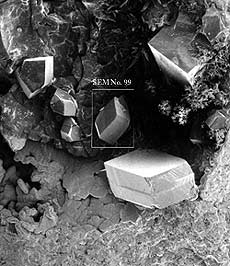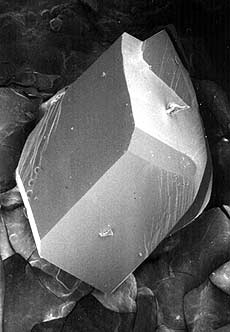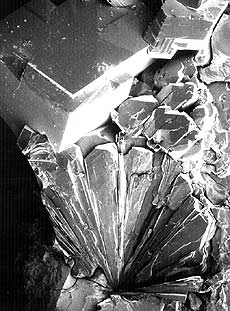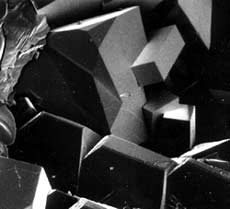CHABAZITE FROM THE EBURRU STATION HYDROTHERMAL LOCALITY Chabazite is the most abundant zeolite present. Typically it occurs as individual crystals and in small clusters scattered in small vugs lined with a pale grey-blue clay mineral. Triclinic 'cubes' and penetrtion twins are most common. In most areas, there are no other associated minerals, but in some narrow zones chabazite is found together with stellerite, calcite, a variety of very simply shaped crystals that might be heulandite or laumontite, and other unidentified minerals. The SEMs below were obtained while looking for other unknowns and are not a good representations of the most common forms present. | |
 5-14-86 No. 98 5KV APER200 x50 by CMN |
THIS TABLE LOOKS BEST WITH INTERNET EXPLORER. MAGNIFICATION FIGURES ARE FOR THE ORIGINAL SEMs, NOT FOR THE IMAGES YOU SEE ON YOUR COMPUTER SCREEN. I WILL BE ADDING SCALE BARS WHEN I HAVE TIME TO DO THE CALCULATIONS. Chabazite Colorless. Various kinds of triclinic twins. Occurs in vugs with callcite, stellerite and unidentified zeolites, possibly including heulandite. |
 5-14-86 No. 99 5KV APER200 x200 by CMN |
Chabazite Colorless. Six triclinic twinswith 0112 facess clearly evident. Occurs in vugs with callcite, stellerite and an unidentified zeolite, possibly heulandite. |
 5-7-86 No. 94 5KV APER200 x75 by CMN |
Unknown zeolite (detail below) Chabazite (at left) Triclinic twins. Top of stellerite terminations (detail below) Radiating xls of stellerite Intergrown stellerite & chabazite |
 5-14-86 No. 91 5KV APER200 x320 by CMN |
Chabazite Colorless. Penetration twins midground. Stellerite in foreground. Occurs in vugs with callcite, stellerite and unidentified zeolites, possibly including heulandite. |